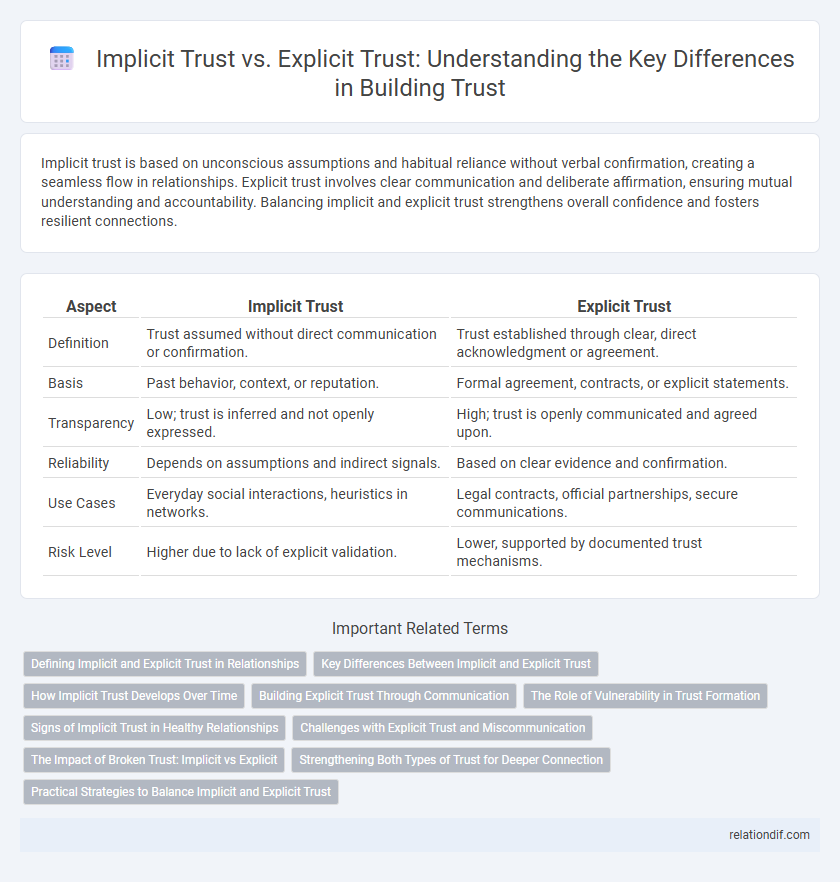Implicit trust is based on unconscious assumptions and habitual reliance without verbal confirmation, creating a seamless flow in relationships. Explicit trust involves clear communication and deliberate affirmation, ensuring mutual understanding and accountability. Balancing implicit and explicit trust strengthens overall confidence and fosters resilient connections.
Table of Comparison
| Aspect | Implicit Trust | Explicit Trust |
|---|---|---|
| Definition | Trust assumed without direct communication or confirmation. | Trust established through clear, direct acknowledgment or agreement. |
| Basis | Past behavior, context, or reputation. | Formal agreement, contracts, or explicit statements. |
| Transparency | Low; trust is inferred and not openly expressed. | High; trust is openly communicated and agreed upon. |
| Reliability | Depends on assumptions and indirect signals. | Based on clear evidence and confirmation. |
| Use Cases | Everyday social interactions, heuristics in networks. | Legal contracts, official partnerships, secure communications. |
| Risk Level | Higher due to lack of explicit validation. | Lower, supported by documented trust mechanisms. |
Defining Implicit and Explicit Trust in Relationships
Implicit trust refers to the automatic, unconscious confidence individuals place in others based on familiarity, social norms, or past experiences, without requiring direct communication or confirmation. Explicit trust, in contrast, involves clearly articulated agreements, promises, or commitments that are openly expressed and acknowledged within relationships. Understanding the dynamics between implicit and explicit trust is crucial for fostering deeper interpersonal connections and navigating complex social environments effectively.
Key Differences Between Implicit and Explicit Trust
Implicit trust relies on unconscious assumptions based on past experiences and social cues, whereas explicit trust is consciously granted through clear agreements or confirmations. Implicit trust involves automatic, intuitive acceptance without direct verification, while explicit trust requires deliberate communication and mutual acknowledgment. The key difference lies in the transparency and intentionality of trust establishment, with explicit trust being more measurable and documented compared to the subconscious nature of implicit trust.
How Implicit Trust Develops Over Time
Implicit trust develops gradually through repeated positive interactions and consistent behavior, allowing individuals to form expectations without verbal agreements. This trust is deeply rooted in subconscious experiences, emotional bonds, and observed reliability, making it more resilient and intuitive than explicit trust. Over time, the accumulation of shared experiences and demonstrated dependability strengthens implicit trust, creating a foundation for long-term relationships and cooperation.
Building Explicit Trust Through Communication
Building explicit trust through communication involves clear, transparent dialogue that sets defined expectations and responsibilities between parties. This process strengthens relationships by fostering mutual understanding, accountability, and reliability, which are fundamental components of explicit trust. Consistent and open communication channels help mitigate misunderstandings and reinforce trustworthiness in personal and professional interactions.
The Role of Vulnerability in Trust Formation
Vulnerability plays a crucial role in distinguishing implicit trust from explicit trust by creating an environment where individuals willingly expose their weaknesses or uncertainties. Implicit trust develops subconsciously through consistent, repeated interactions without formal acknowledgment, whereas explicit trust is consciously granted after deliberate evaluation of reliability. This dynamic highlights vulnerability as a catalyst for deepening relational bonds and fostering authentic trust formation.
Signs of Implicit Trust in Healthy Relationships
Implicit trust in healthy relationships is characterized by seamless communication, where partners understand each other without constantly needing verbal reassurance. Mutual respect and consistent reliability create an environment where both parties feel secure without explicit guarantees. This trust manifests through shared vulnerability, intuitive support, and confidence in each other's intentions.
Challenges with Explicit Trust and Miscommunication
Explicit trust requires clear communication and agreed-upon expectations, but it often faces challenges due to ambiguity in language and differing interpretations. Miscommunication can erode trust when explicit agreements are misunderstood or not properly conveyed, leading to conflicts and reduced collaboration. Navigating these challenges demands precise dialogue and consistent feedback to maintain alignment and prevent trust breakdowns.
The Impact of Broken Trust: Implicit vs Explicit
Broken implicit trust often leads to confusion and uncertainty, as it operates beneath conscious awareness, causing individuals to question underlying assumptions and emotional bonds without clear evidence. In contrast, broken explicit trust involves clear, documented expectations and commitments, resulting in direct feelings of betrayal and a measurable impact on relationships or agreements. Understanding the distinct dynamics of these trust types helps organizations and individuals implement targeted strategies for rebuilding confidence and repairing damaged interactions.
Strengthening Both Types of Trust for Deeper Connection
Implicit trust relies on subconscious comfort and shared experiences, while explicit trust depends on clear communication and overt agreements. Strengthening both types involves consistently demonstrating reliability through transparent actions and fostering emotional connection through empathy and active listening. Combining these approaches builds a deeper, more resilient bond that withstands challenges and promotes mutual understanding.
Practical Strategies to Balance Implicit and Explicit Trust
Balancing implicit and explicit trust requires implementing clear communication channels while fostering an environment where unspoken confidence can naturally grow. Practical strategies include setting transparent expectations combined with regular feedback loops to validate trustworthiness, alongside encouraging autonomy to empower individuals through implicit trust. Leveraging trust-building frameworks such as Trust Equation and Continuous Trust Calibration helps organizations maintain equilibrium between assumed reliability and verified accountability.
Implicit trust vs explicit trust Infographic

 relationdif.com
relationdif.com